Project
12 : Collaboration Pete Clarke and Georg Gartz
Conversations
in Colours
Sometimes a painter discovers in the pictures of another
artist a surprising proxi¬mity to his own work. Maybe
it is the colours, maybe the way in which the brush is
used. Maybe it is the mysterious harmony of the many small
parts that make up the whole. Or even all of these things
together. At the same time this feeling of proximity is
combined with the awareness of dissonance within the similarities;
this ounce of uniqueness which distinguishes the handwriting
of one painter from the next and makes it unmistakably
individual.
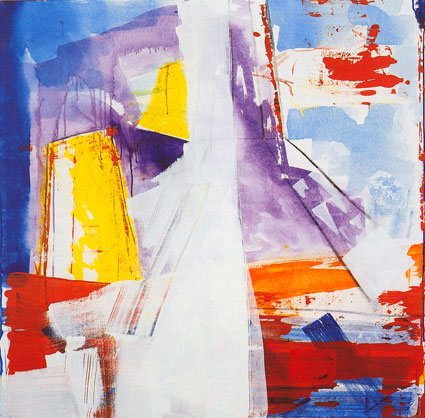
Fifties
Cathedral
(Acrylic on canvas,100 x 100 cm, Oct. 1999)
But
what happens when two such related painterly styles come
together: on one canvas, in one picture? This does not happen
often, for after all art is generally an individualist enterprise
and artists independently minded as most of them are avoid
collaboration in joint pictorial projects. Possibly this
is because they feel worried that they themselves would
disappear in the process and cease to be the person who
they are only through their art. Possibly, however, the
main reason is that they have not learned that artistic
collaboration involves more than conversa¬tion with
oneself but rather also a dialogue with another person.
Since the Enlightenment art has been presented time and
again as a lonely, often tragic adventure, full of freedom
and individualism, without compromise, often hermetic and
incomprehensible. This idea defines the myth of art to the
present day. Most artists seemingly put far more emphasis
on their individuality than on the subject and content of
their work. Increasingly the individuality of artistic handwriting
became the core issue of art and since then every artistic
statement that could cause this individuality to diminish,
has been avoided as a place of great danger.
But why should the brush strokes of two artists not touch
each other like the fingers of a hand? And does it not suggest
itself that painters too, should occasio¬nally work
jointly like lone athletes who occasionally invest their
individual skills in a team effort and thus let their individual
strengths and weaknesses appear in a wholly different light.
(Many artists are even opposed to such metaphors.) For this
one needs two quiet reserved characters who are prepared
to let another person make use of their own colours and
forms. They have to be open and relaxed souls, full of trust
that in the exchange with the other their own work can be
altered but not destroyed. And they have to possess the
curiosity that makes them want to see their own colours
and artistic gestures in an unexpected manifestation. All
this is true for Georg Gartz and Pete Clarke who met each
other three years ago.
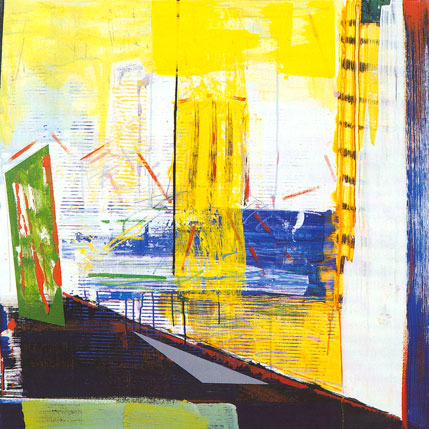
Yellow
Cathedral
(Acrylic on canvas,100 x 100 cm, Oct. 1999)
Before Pete Clarke showed some of his pictures in an exhibition
in the Lichthof in Cologne, Georg Gartz had already seen
them in his Liverpool studio. And for his part Pete Clarke
got to know the paintings of the Cologne artist Georg Gartz
in his studio before he showed his works in the Basement
Gallery in Liverpool. The exhi¬bitions were part of
a lively exchange between artists from Cologne and Liverpool
which has been going on for some time between the two cities.
One reason for this exchange is that despite the idea of
European union people in the Northwest of England and those
in the West German Rhineland actually still know (too) little
of each other. Is modern art, which after all has been recognised
as an international language, the same in both regions?
Have individual experiences of painting the same foundation
in both areas? And does the love of colour possibly transcend
all influences of society by touching sentiments which are
the same all over Europe?
Georg Gartz and Pete Clarke told themselves that here was
an issue which was ripe for discussion in painting. Thus
they started to exchange their experiences on canvas.
What is important is that the joint works of Pete Clarke
and Georg Gartz do not just represent the sum of two approaches
but that a new third conception has emerged which is more
than the sum of its parts. The painters leave enough room
for each other on the canvas to let a dialogue of colours,
shapes and pictorial gestures arise. One painter starts
it all; with a colour, with a undefined outline and the
other continues it. For the time being each one leaves untouched
what the other has painted. At first the transformation
happens by means of addition so that the picture becomes
increasingly dense; the change happens through a gradual
process of growth. They work very carefully in order to
avoid destroying and erasing the other's brush strokes,
even if this cannot be completely avoided. The canvas is
not understood as a battlefield but as a zone of deliberate
and careful understanding. Out of a trickle of colour arises
the outline of bridge. An alarming red is soothed by its
surroundings. A box like shape protrudes from the colour
like a persistent signpost and many fluid traces come together
to form a resting structure.
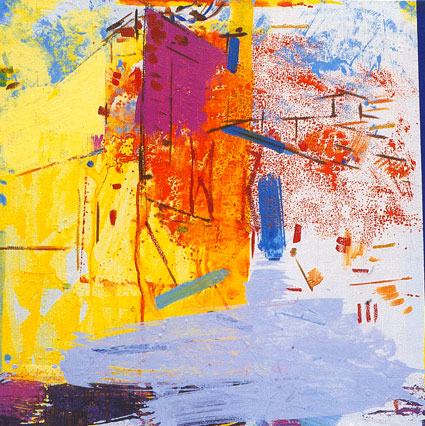
Magenta
and Yellow Facade
(Acrylic on canvas, 50 x 50 cm, March 2000)
Pete and Georg always work on more than one picture at the
same time. After they have swapped and continued their pictures
several times without comment they finally start a verbal
dialogue. The talking is part of the collaborative creative
pro¬cess. They talk about how they should proceed or
if they should add something here or cover something there.
Each has different ideas and experiences as to which colours
work as a harmonic whole. Especially the drawings (which
appear harder edged than the works on canvas because the
paper does not soak up the colour) show that the painting
is also a matter of opposing dynamics: a layering, and extinguishing
of colours and marks which the other has previously placed.
One painter gets into cul de sacs and dead ends with his
colours and the other will once more set in motion or simply
see something different. In any case crea¬ting harmony
is a difficult process.
Does one painter question the other? Does his addition extend
the possibilities available to the other? What does it mean
to question and to assert ones personal creative impulse
in the process of exchange? What does it mean to accommodate?
In this way the creative process becomes a model of a dialogue
of equals. Colours are placed into space, tentatively or
boldly, carefully or distinctly, slightly questio¬ningly
or as A confident statement and always begging further comment.
The objective is to react to a painted comment: to dovetail
or to contrast. One artist picks up the colours of the other
and adds his own colours. Colours approximate each other,
resist each other, confront each other as strangers and
challenge each other. They embrace each other and illuminate
each other, stick to another, rub against each other or
appease each other. They hover or mingle in dense crowds.
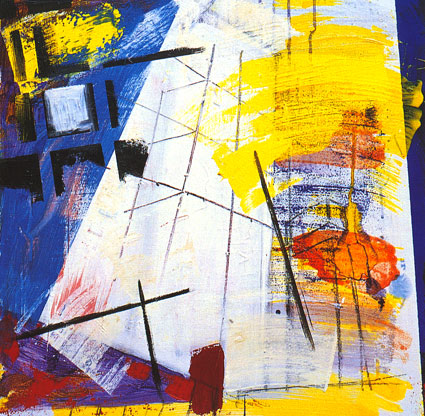
Layered
Like glass.
(Acrylic on canvas, 50 x 50 cm, March 2000)
They appear as whisks or as organic scatterings, as a trickle,
the impression of a material, a splash or a geometric shape.
Innumerable abstract fragments interlock to form an insoluble
unit and the balance of colours comes to represent the balan¬ce
of life as a whole. There are countless possibilities of
losing and re finding one¬self in the colours. Only
the creations of one painter make it possible for the other
to arrive at his own creations. The painted reactions alternately
become barriers and complements, forces of resistance and
brackets. Thus it all adds up.
Indeed, most of the pictures by Georg Gartz and Pete Clarke
have a motif that in many cases has been rendered unrecognisable.
In some paintings an architectural shape sticks out such
as the outline of a church, a tower, a high rise block.
The other canvases appear abstract images of turmoil that
have found their balance in a state of anonymous dynamism,
in the tension of opposites, as a harmony of differences.
The results are pictures of manifold permeation in which
the contribu¬tion of each painter has been blurred.
Often the artists themselves have difficulty retracing their
steps. This experience is as much part of artistic contact
as of every other type of communication.
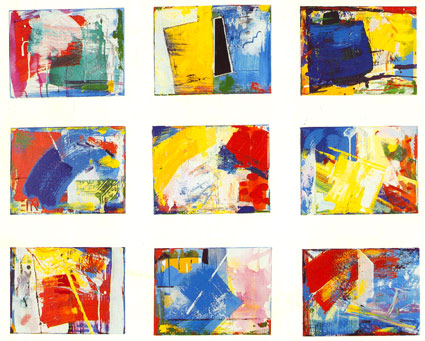
SmallKoln
Paintingl.
(Acrylic on canvas, 30 x 40 cm, Oct 1999)
Georg
Gartz and Pete Clarke never paint simultaneously on one
canvas but they always take turns. They also work on more
than one canvas at the same time. One begins to talk, the
other replies, then again the first and so on. Each according
to his own abilities, his own ideas, each against the background
of his long standing experience as an artist. The paradox:
the process causes the characteristics of the painters individual
hand writing to change and to disappear in a larger whole.
Clarke, whose paintings are often characterised by figurative
elements, fragments of writing and architecture, even flower
motifs, plunges into Gartzs freely abstract colouring and
is led to greater abstraction in his own use of colour.
Gartz, on the other hand, who has long banned figurative
elements from his painting, is led by Clarke to the edge
of figurative depiction. The greatest artistic achievement
in every picture is its balance and that is achieved when
neither of the two artists wants to add any more touches
of colour. Indeed they manage to integrate their in¬dividual
artistic handwriting into one joint work and thus to subsume
it in the whole for a moment. This points to an exemplary
concept: to use individual experiences and possibilities
in such a way that a common experience is created and this
rela¬tivises the myth of (artistic) individuality to
a significant extent.
A new artistic category is introduced: artistic creation
functions as a bridge to active mutual understanding. Painting
as a coming together through colours. Probably it is no
coincidence that both artists also work as art educators:
Pete Clarke as Senior Lecturer in Painting at the University
of Central Lancashire and Georg Gartz as Museum Education
Officer at the Museum Ludwig in Cologne. It is characteristic
of both that they do not separate their educational artwork
from their painting but regards it as an experience that
their painting also benefits from.
Naturally, it did not all come together harmonically right
from the start. Artistic colla¬boration is a matter
of achieving a finely tuned balance. In the first joint
works it was sometimes still the case that one painter dominated
the picture, not on purpose but still unmistakably visible
(maybe because one painted a touch more boldly, maybe because
one was more careful). Ideal balance was only achieved after
the second or third painting session, especially because
both artists possess the rare gift of measured self restraint.
Their painting is marked by reciprocal empathy not by competition.
Both have reliable intuition when it comes to harmonising
colours even if they represent disjunctures and contrasts.
Both are seeking the orchestration of many smaller elements
in a coherent whole rather than allowing one expression
to dominate. And neither is interested in posting obvious
messages but in the quiet yet exciting subtlety of a process
of painting in which the opaqueness of our experience gives
rise to poetic feeling. Joint painting of this kind is an
open, intentionless dialogue. It is the art of being sensitive,
curious (that is, hungry to experience the new) and without
hidden agendas as attentive to ones own emotions as to those
of the other.
Of course, Georg Gartz and Pete Clarke are not the first
artists who have painted pictures together. In the 1980s
Andy Warhol and Jean Michel Basquiat worked on several large
scale canvases in which Basquiat's brattishness enlivened
Warhols tired art stencils in an unexpected way. Several
decades ago Dieter Roth and Stefan Wewerka created wildly
animated joint works out of the mood of their meetings.
The Fluxus artists in their most radical period in the middle
of the rebel¬lious sixties were also very keen on the
collaborative art project. And the so called Young Wild
Ones, painters of the 1980s such as Walter Dahn and un Dokoupil
occasionally collaborated in a painting in order to satiate
their hunger for pictures. And then there is the group of
painters who only ever appear in public as a couple but
that is yet another story.
The fact that Georg Gartz and Pete Clarke come from different
countries only makes their common artistic project even
more compelling. It is not the fashionable Crossover that
is introduced but the ideal of a synthesis in which the
question after the difference is no longer important. They
have found a way of collaborating that has long been employed
in the sessions of Jazz and Blues musicians. Against the
background of a common sound environment and on the basis
of a shared motif musicians of the most varied cultural
circles develop an individual style, improvising with great
enjoyment, in order to then integrate their individual conception
into the larger body of music. Both artists like Jazz. And
the fact that they listen to music while they paint confirms
that in their art they put more emphasis on the right rhythm
than on theoretical concepts.
Jurgen Kisters
Köln Hdhenhaus, March 2000
(Translation: Dr. Christina Thomson)
Acknowledgements
We first thougt it would be fun and interesting to collaborate
together on a painting project during 'Eight Days a Week'
in Cologne 1998. Since then we have been working together
like two jazz musicians in a creative dialogue revisiting
ideas about authorship, spontaneity and authenticity in
contemporary painting.
We are excited by the work we have made, but it would never
have happened without the encouragement and support of many
people, institutions and friends.
We would especially like to thank, Jurgen Kisters, Bryan
Biggs and 'Eight days a Week.